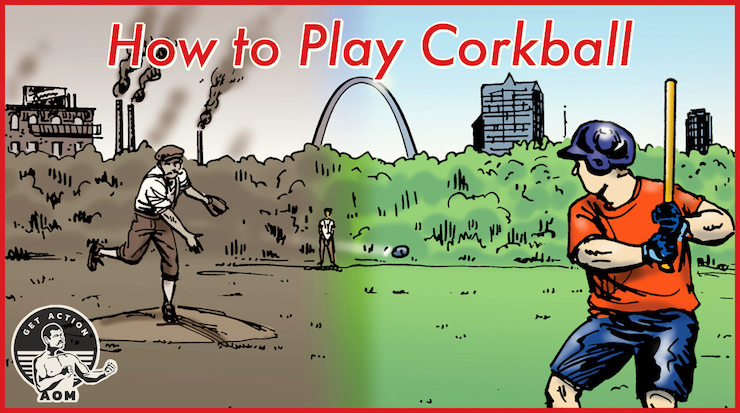
The batter tightens his grip around the bat and stares down the pitcher with a flinty look.
The pitcher winds up and hurls the ball with all his might.
WOOSH
PLOP!
As the golf-ball-sized ball lands in the catcher’s mitt, the struck-out batter dejectedly walks away from the plate, leaving his broomstick-width bat behind.
Wait, what? Why are the ball and bat so slimmed down?
What might have initially sounded like a game of baseball isn’t America’s pastime at all. Rather, it’s a regional speciality that originated in the taverns, factories, and schoolyards of the early 20th century.
Welcome to corkball: a mutant baseball game hailing from the streets of St. Louis, that you just might want to import to your own neighborhood.
The Origins of Corkball
In the 1840s, Irish and German immigrants came pouring into St. Louis. Many of the latter brought beer recipes from Deutschland and opened breweries that mass-produced German lagers for the country’s growing population. While brewing companies like Anheuser-Busch were innovating beer-making with pasteurization and refrigeration, the employees at these breweries were making innovations to American baseball and created a version of the game that allowed them to play with a limited number of players, in a limited space, without the usual regulation equipment.
Legend has it that corkball got its start in an east St. Louis tavern sometime around 1900. Some bored, slightly drunk dude popped the cork bung off a beer barrel and wrapped some tape around it. He then tossed it to a drinking buddy who tried to hit it with a broomstick.
Boom!
Corkball was born.
The most significant difference between corkball and baseball was that corkball had no runners, so there were no bases. Because there were no bases or runners, men didn’t need a big space or many players to play corkball. They could technically get a corkball game going with just four total — two to a team.
Corkball is obviously all about pitching and hitting. But the game’s uniquely small ball and bat make the latter frustratingly tricky. While corkball could be played with a broom and a homemade ball made with a taped-up cork bung, a few sporting goods companies like Spalding and Louisville Slugger started manufacturing “regulation” corkball equipment. A regulation corkball bat has a thin 1.5″ barrel at its widest point, about the width of a broomstick. A regulation corkball looks like a standard baseball but is smaller in size. It’s only 6.5″ around and weighs a measly 1.5 ounces (a regulation baseball is 9” round and weighs 5 ounces). Because the corkball is so light, throwing modified pitches, like curves and sliders, is much easier to do than with a regular baseball.
In the decades after its turn-of-the-century inception, corkball got somewhat more sophisticated, but not much. General rules were established, but each tavern, factory, or schoolyard had its own “home field” rules. The game was so popular with St. Louis tavern-goers that many pubs built “corkball cages” in the alleys behind their establishments. Supposedly, you can still see a few abandoned corkball cages here and there around the city.
The game of corkball spread a bit outside the Gateway to the West thanks to WWII. GIs from St. Louis taught the game to their fellow bored
No comments:
Post a Comment